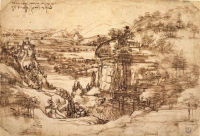The Body of Earth Click on the thumbnails to explore the trail
Read more about this trail (expand)
In his vision of the world, Leonardo saw the planet earth as a living entity, with all of its elements in a constant state of flux. As in nature form follows function, the landscape and all of its elements is seen as a product of the effects of nature that illustrates the bodily mechanisms of the earth.

- Enlarge
- Zoom & explore
- © Soprintendenza Speciale Polo Museale Fiorentino
Landscape drawing 1473
Leonardo’s study of the landscape began early in his artistic career. The inscription on this drawing, written in Leonardo’s characteristic mirror-writing reads, “(feast) of Saint Mary of the Snow/ - day of August 5th, 1473”. As such, it is Leonardo’s earliest surviving drawing, executed when he was just 21 years old.
Attempts to identify the location on which Leonardo based his study have been unsuccessful. It is likely to be an imaginatively re-created vision of the Arno valley seen in bird’s eye view, as perhaps envisaged from a hillside on Montalbano near Vinci.
The drawing is a testament to Leonardo’s early ability to invent natural forms according to his own creative will. Feint traces of lines beneath the pen and ink may indicate that he may have first sketched the features of the landscape, perhaps in situ, and then later re-enforced the lines in his studio, making subtle changes and additions. The drawing expresses a new sensitivity towards light and space on the part of Leonardo, the effects of which are perfectly captured in a mesh of curved and parallel hatched lines rapidly applied with the pen.
In Leonardo's words
If the painter wishes to see beauties that would enrapture him, he is master of their production,…And if he wishes to produce places or deserts, or shady or cool spots in hot weather, he can depict them...If he seeks valleys, if he wants to disclose great expanses of countryside from the summits of mountains, and if he subsequently wishes to see the horizon of the sea, he is lord of all of them.
The inscription on this drawing, written in Leonardo’s characteristic mirror-writing reads “(feast) of Saint Mary of the Snow/ -day of August 5th, 1473” and indicates that this is Leonardo’s earliest surviving drawing, drawn when the artist was just 21 years old.
Attempts to identify the exact location on which Leonardo based this study have proved unsuccessful, indicating that this is likely to be an imaginatively re-created vision of the Arno valley in a bird’s eye view, as envisaged from a typical hillside on Montalbano near Vinci, Leonardo’s home town or elsewhere in Tuscany.
The drawing is a testament to Leonardo’s early study of nature and to his ability to redefine forms according to his own creative will. Feint traces of lines beneath the pen and ink may indicate that Leonardo first sketched the main features of the landscape, perhaps in situ, and then later, in his studio, re-inforced the lines, making subtle changes and additions.
The drawing also expresses a new sensitivity towards light and space on the part of the artist, the effects of which are perfectly captured in a mesh of curved and parallel dynamic, hatched lines, rapidly applied with the pen and ink.
- Medium Pen and ink over lead point underdrawing
- Size 19 x 28.5 cm
- Location Gabinetto dei Disegni e delle Stampe degli Uffizi










